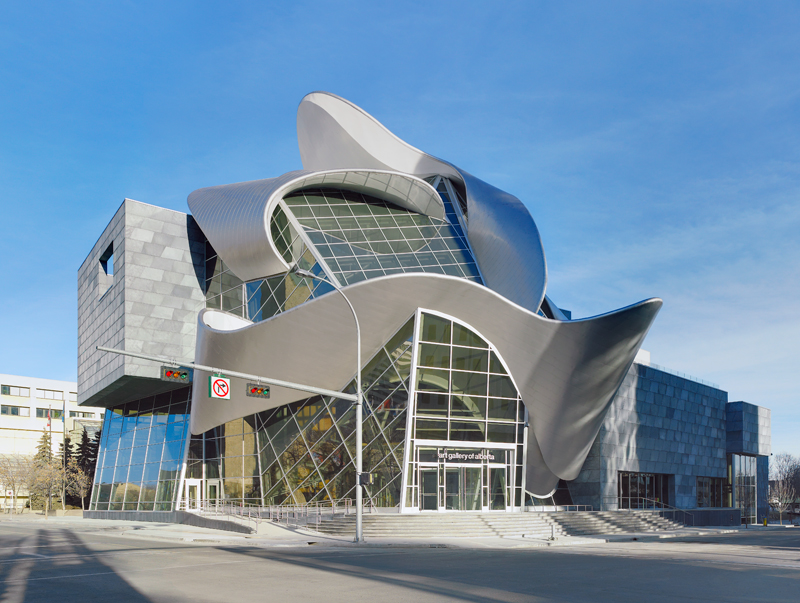Late last week, a CBC article began circulating claiming the Art Gallery of Alberta had requested $750,000 in emergency funding from the Edmonton Arts Council and had been rejected, leaving the institution’s future uncertain.
This was titillating, but not entirely true. The request was not for emergency funds, and the institution was not on an irreparable downward spiral. The AGA quickly tried to stamp out the misunderstanding with a statement. This was a PR problem, not a financial gaffe.
The Switch to Free Admission
If there’s room to worry, it’s with audience attendance rates rather than operating costs (the institution has delivered a balanced budget for the last three fiscal years). “We had a spike in 2010 when we opened, that was anticipated, that’s what happens with new buildings—visitors come to see the new building,” says AGA executive director and chief curator Catherine Crowston.
“That fell off in 2011. Then there has been a steady line in 2013, 2014, 2015. Management is saying, ‘If you can attract that many people in the first and second years by curiosity, how can we get them back? How can we have those people re-engaged?’”
One possible solution: shifting to a free-admission model. It’s an approach that has been getting increasing attention in the US recently. The Hammer Museum in Los Angeles switched to free admission in February 2015 and reported a 25% increase in visitors. In October, MoMA PS1 announced that they’d offer free admission for New Yorkers in 2016. Both the Dallas Museum of Art and the Bronx Museum of the Arts are experimenting with free admission.
For the AGA, free admission is an attractive approach not only because it gets more bodies in the building, but also because it attracts a different type of audience. The gallery already has several free-admission days sponsored by various corporations, including monthly Thursdays, Canada Day and Family Day. “When we have these free days, we see our attendance spike,” says Crowston, “but more importantly, during these free days our audience demographic shifts. We have new citizens, multi-generational groups, so there’s a whole different use of the gallery.”
With this aim in mind, the AGA began creating a strategic plan last year, approved by the board of directors in October, that included the big shift to a free-admission model alongside a number of other changes, such as altering public hours, launching new provincial outreach and educational programs and more.
To realize these goals, the gallery settled on an ambitious three-year transition plan, which is where the funding request from City Council, created with support from city administration and the Edmonton Arts Council, came in.
A Cautious Future
Although the transition plan can’t begin immediately, the AGA intends to stick to their new strategic plan.
The $750,000 funding rejection will, notes Crowston, “potentially slow down the transition plan.” But the gallery is looking to support from other sources and levels of government to meet their new goals.
“Our intent is to go forward with the objectives. Some of them are easier to implement, or allocate different budgetary funds to, on the outreach side. On the visitor experience side, our biggest question is: Is it financially feasible right now to walk into a free admission model when we’re potentially going to lose over $300,000 in admission revenue?”
Larger Lessons
As new buildings for museums and galleries continue to crop up across the country, in Vancouver, Ottawa, Saskatoon, Toronto, Calgary, Whistler and more, Crowston has some advice: “Be very realistic about anticipation of increased funding from public sources; there was an expectation from the previous director and board that there would be an increase that we didn’t actually see.
“Also be very realistic, and perhaps conservative, about what your fund-development expectations can be. Ours are very high at the moment—just on corporate sponsorship alone, it’s in the neighbourhood of $800,000 a year. It’s a significant target in Alberta, and it becomes particularly complicated when you are in an economic situation as we are in now.”
There’s no real way of knowing what actual operating costs will be, notes Crowston, and securing the funding for the construction of the building is really only one step in a much larger, more difficult picture.
Other Institutions Will Be Affected
While much of attention was directed to the AGA’s rejection, Edmonton City Council’s funding decisions will affect a range of organizations in the city.
The Edmonton Arts Council requested $397,000 over two years for operation, and was funded $120,000 a year for three years. Their requests for a one-time service package of $257,000 spread over two years for an assessment of the Civic Art Collection and $400,000 over three years to meet demands on their grant programs in order to return funding for arts organizations and festivals to the 8% and 12% targets set by the Art of Living were deferred for discussion next year. Although the current municipal government is considered generally supportive of the arts, there is a sense that they are tightening the purse strings.
The Edmonton Arts Council was optimistic when commenting on the decisions, noting that they “understood going in that this would be a difficult budget year for [the Mayor and City Council]. We were therefore pleased to receive the $120,000/year for three years for operations. We are optimistic for the opportunity to come back and discuss the needs of the community with Council next year, including the requests that were deferred.”
But these decisions have widely felt ramifications. As Todd Janes, director of Edmonton artist-run centre Latitude 53 notes, the council’s decisions “will impact not just the Art Gallery of Alberta, but they will impact every arts organization in our city that received project or operational support.”

 The Art Gallery of Alberta. Photo: Robert Lemermeyer.
The Art Gallery of Alberta. Photo: Robert Lemermeyer.







